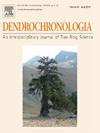Understanding physiological mechanisms of European beech dieback responses to climate using a triple isotope approach in northern Switzerland
IF 2.7
3区 农林科学
Q1 FORESTRY
引用次数: 0
Abstract
To investigate which physiological predispositions led to the drought-induced vitality decline in beech (Fagus sylvatica L.) following the severe 2018 drought, we studied trees with premature leaf discoloration and shedding (early-browning trees) and trees showing no symptoms (vital trees) in a forest in northern Switzerland. We analyzed annual tree-ring width (TRW) and applied a triple isotope approach (i.e., carbon (δ13C), oxygen (δ18O), and hydrogen (δ2H) isotopes) in tree-ring cellulose for the period 1960–2020. To retrieve tree physiological responses, we normalized the tree-ring δ values to temporal isotopic variations in CO2 or precipitation (Δ). Δ13C and Δ18O values suggest that the early-browning trees had a more conservative water-use strategy and lower stomatal conductance than the vital trees in the initial decades of the measurement period. However, several decades before the onset of crown dieback in 2018, the early-browning trees showed a decrease in TRW and an increase in Δ2H, suggesting a higher use of carbon reserves for the early-browning trees. These long-term trends may be the first signs of a progressive deterioration of the physiology of the early-browning trees. During and after the 2018 drought, changes in Δ2H suggested high carbon investments into drought damage repair for the early-browning trees. Moreover, a higher TRW and isotope sensitivity to previous year’s summer climate in early-browning than vital trees suggests stronger negative carry-over effects. Our findings highlight that the early-browning trees may have already been weakened before the 2018 drought, eventually pushing them beyond their physiological tipping points and inducing dieback.
利用三同位素方法了解瑞士北部欧洲山毛榉枯枝对气候响应的生理机制
为了研究在2018年严重干旱之后,哪些生理倾向导致了山毛榉(Fagus sylvatica L.)干旱诱导的活力下降,我们研究了瑞士北部森林中叶子过早变色和脱落的树木(早褐树)和没有症状的树木(生命树)。我们分析了1960-2020年树木年轮宽度(TRW),并应用三同位素方法(即碳(δ13C)、氧(δ18O)和氢(δ2H)同位素)分析了树木年轮纤维素。为了获取树木的生理响应,我们将树木年轮δ值归一化为CO2或降水的时间同位素变化(Δ)。Δ13C和Δ18O值表明,在测量期的最初几十年里,早褐变树木的水分利用策略更为保守,气孔导度也比重要树木低。然而,在2018年树冠枯死发生的几十年前,早褐变树的TRW下降,Δ2H增加,这表明早褐变树的碳储量使用更高。这些长期趋势可能是早褐树的生理机能逐渐恶化的第一个迹象。在2018年干旱期间和之后,Δ2H的变化表明,对早褐变树木的干旱损害修复进行了高碳投资。此外,早褐变树木对前一年夏季气候的TRW和同位素敏感性高于重要树木,表明负携带效应更强。我们的研究结果强调,早褐树可能在2018年干旱之前就已经被削弱了,最终使它们超过了生理临界点,并导致枯死。
本文章由计算机程序翻译,如有差异,请以英文原文为准。
求助全文
约1分钟内获得全文
求助全文
来源期刊

Dendrochronologia
FORESTRY-GEOGRAPHY, PHYSICAL
CiteScore
5.50
自引率
13.30%
发文量
82
审稿时长
22.8 weeks
期刊介绍:
Dendrochronologia is a peer-reviewed international scholarly journal that presents high-quality research related to growth rings of woody plants, i.e., trees and shrubs, and the application of tree-ring studies.
The areas covered by the journal include, but are not limited to:
Archaeology
Botany
Climatology
Ecology
Forestry
Geology
Hydrology
Original research articles, reviews, communications, technical notes and personal notes are considered for publication.
 求助内容:
求助内容: 应助结果提醒方式:
应助结果提醒方式:


